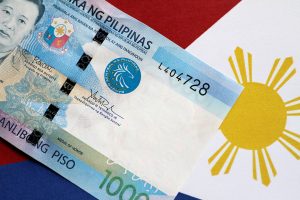




Philippines Trade Update: Trade trajectories trend along
 DOWNLOAD
DOWNLOAD

Policy Rate Updates: Double cut finale
 DOWNLOAD
DOWNLOAD

Monthly Economic Update: One for the road
 DOWNLOAD
DOWNLOAD


PH debt now at 61% of GDP as of end-March

THE NATIONAL GOVERNMENT’S (NG) outstanding debt as a share of the gross domestic product (GDP) inched up to 61% as of end-March.
Data from the Bureau of the Treasury (BTr) showed that the latest quarterly debt-to-GDP ratio was slightly higher than the 60.9% seen as of end-December.
This was also still above the 60% threshold considered manageable by multilateral lenders for developing economies.
At 61%, the latest debt-to-GDP ratio is higher than the 60.4% at the end of 2021, and 39.6% at the end of 2019 or before the pandemic.
The latest debt-to-GDP ratio was also within the 60-62% target under the Philippine Development Plan.
The NG outstanding debt stood at a record-high PHP 13.86 trillion as of end-March, “primarily due to the net issuance of domestic and external debt.”
The Philippine economy grew by 6.4% in the first quarter, the slowest expansion in two years or since the 3.8% contraction in the first quarter of 2021.
The debt stock was equivalent to 57.2% of the gross national income, while the debt service bill was equivalent to 7.6% of GDP.
“Higher interest rates that increased borrowing and debt servicing cost could still lead to new record higher outstanding National Government debt levels and debt-to-GDP,” Rizal Commercial Banking Corp. Chief Economist Michael L. Ricafort said in a Viber message.
To tame inflation, the Bangko Sentral ng Pilipinas (BSP) has raised borrowing costs by 425 basis points since May 2022, bringing the key policy rate to a near 16-year high of 6.25%.
Security Bank Corp. Chief Economist Robert Dan J. Roces said that the debt-to-GDP ratio will likely remain elevated in the near term due to the borrowings incurred during the pandemic.
“The recent GDP print is actually good in terms of the outlook for debt, for as long as we grow by 6% in the next six years, debt-to-GDP will actually normalize,” he said in a Viber message.
The government aims to cut the debt-to-GDP ratio to less than 60% by 2025, and further to 51.5% by 2028.
“The debt-to-GDP ratio could again be reduced to as low as 50% levels or even lower than 50% in the coming years if the economy significantly grows alongside the fiscal reform measures but it would take longer this time due to the larger government debt incurred during the pandemic,” Mr. Ricafort added.
DEFICIT-TO-GDP
In a Viber message to reporters, Finance Secretary Benjamin E. Diokno said the deficit-to-GDP ratio stood at 4.84% at end-March.
This is lower than the 6.41% in the first quarter a year ago and the 7.33% seen in 2022.
The NG’s budget gap narrowed by 14.51% PHP 270.9 billion in the January-to-March period, falling short of its PHP 298.705-billion ceiling.
For March alone, the fiscal deficit widened by 12.04% to PHP 210.3 billion.
This year, the government has set a budget deficit ceiling of PHP 1.499 trillion, equivalent to 6.1% of GDP. — By Luisa Maria Jacinta C. Jocson
This article originally appeared on bworldonline.com





 By BusinessWorld
By BusinessWorld